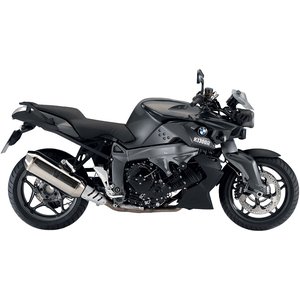BMW K 1300 R (2009–2016): The Power Roadster Reimagined
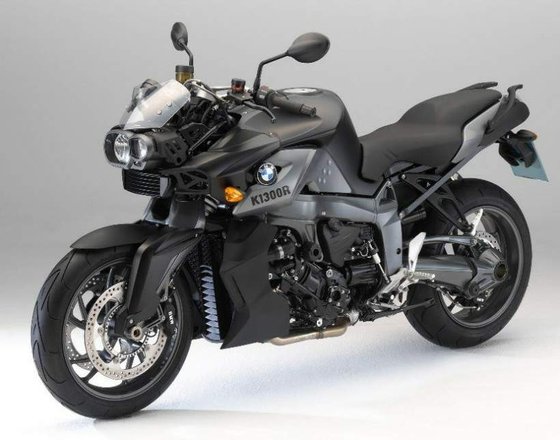
Introduction
When BMW unleashed the K 1300 R in 2009, it wasn’t just updating a model—it was redefining the concept of a naked bike. With 173 hp (127 kW) snarling from its inline-four engine and a design that dared riders to push boundaries, the K 1300 R became an instant icon. Designed as a "Power Roadster," this machine blends Bavarian engineering precision with raw, unfiltered aggression. Over its eight-year production run, it solidified its reputation as a torque-rich, tech-laden beast that could dominate both city streets and winding backroads.
Having recently spent time aboard a well-maintained 2013 K 1300 R Dynamic Edition, I’m here to break down why this motorcycle remains a standout—even in today’s world of hyper-nakeds and electronic wizardry.
Riding Experience: Brutality Meets Refinement
The Heart of the Beast
At the core of the K 1300 R lies a 1,298 cc liquid-cooled inline-four, tuned to deliver 140 Nm (103 lb-ft) of torque peaking at 8,250 rpm. What’s striking isn’t just the numbers—it’s how accessible that power feels. From a standstill, the BMW rockets to 100 km/h (62 mph) in 2.9 seconds, with a visceral growl from its hexagonal exhaust that’s equal parts mechanical symphony and primal roar.
- Low-End Grunt: Over 70% of max torque is available from just 3,000 rpm, making stoplight dashes and highway overtakes effortless.
- Top-End Rush: The engine doesn’t sign off until 9,250 rpm, where it hits its 173 hp peak. At autobahn speeds, the K 1300 R feels unshakable, though wind blast becomes noticeable (a small price for its naked design).
Chassis & Handling: Confidence in Chaos
The K 1300 R’s aluminum bridge frame and Duolever front suspension defy conventional motorcycle geometry. The Duolever system—a BMW hallmark—replaces traditional forks with a dual-arm setup that minimizes dive under braking and sharpens mid-corner stability. Paired with the Paralever rear suspension, the bike feels planted, even when pushing hard through switchbacks.
- Weight Distribution: At 243 kg (536 lbs) wet, the K 1300 R isn’t light, but its mass is centralized. Flicking it into corners requires commitment, but once leaned over, it tracks like a laser.
- ESA II: Optional Electronic Suspension Adjustment allows riders to tweak damping and preload on the fly—a game-changer for transitioning from city potholes to weekend canyon runs.
Ergonomics: Comfort Meets Control
The upright riding position strikes a balance between sportiness and touring comfort. The 820 mm (32.3") seat (lowerable to 790 mm/31.1") accommodates shorter riders, though taller pilots might crave more legroom. Heated grips (optional on earlier models, standard on Dynamic Editions) extend riding seasons, while the sport windshield (a popular add-on) tames highway turbulence.
Quirk Alert: The right-side engine casing occasionally greets your shin at stops—a small reminder of the bike’s mechanical presence.
Design & Features: Functionality with Flair
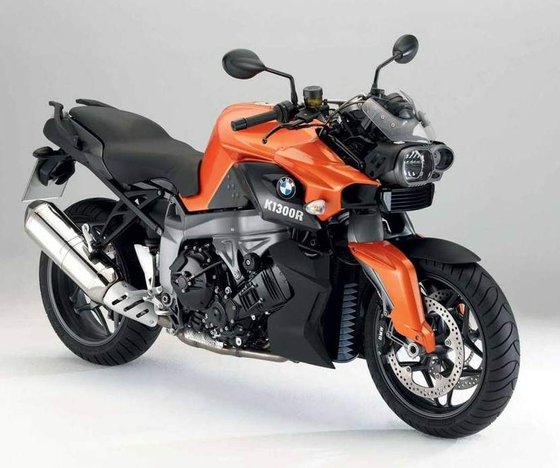
The K 1300 R’s design screams aggression. The chiseled fuel tank, angular radiator shrouds, and minimalist bodywork give it a “bare-knuckle brawler” aesthetic. Over the years, BMW offered eye-catching color schemes like:
- Acid Green Metallic (2011)
- Lava Orange Metallic
- Matte Ostra Grey (2012 Dynamic Edition)
LED turn signals and a clear-lens taillight (post-2010 models) modernized its look, while the Akrapović titanium exhaust (a dealer-fit option) added both decibels and visual drama.
Competition: How Does It Stack Up?
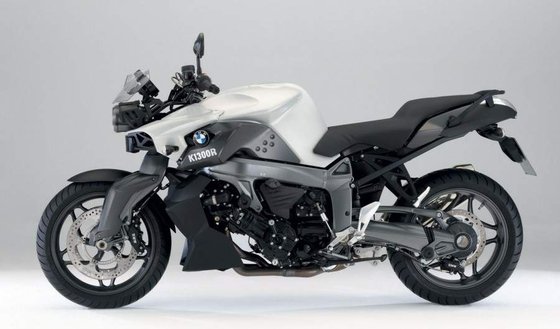
The K 1300 R faced fierce rivals in the liter-class naked segment. Here’s how it compares:
1. Buell 1125CR (2008–2010)
- Engine: Rotax-sourced 1,125 cc V-twin (146 hp).
- Pros: Lighter (199 kg/438 lbs), razor-sharp cornering.
- Cons: Abrupt brakes, punishing ergonomics for city riding.
- Verdict: The Buell excels on twisty roads but lacks the BMW’s refinement and touring chops.
2. Yamaha FZ1 (2006–2015)
- Engine: 998 cc inline-four (150 hp).
- Pros: Lighter, cheaper to maintain.
- Cons: Less torque, basic suspension.
- Verdict: A budget-friendly alternative but doesn’t match the K 1300 R’s tech or presence.
3. Ducati Streetfighter 1098 (2008–2015)
- Engine: 1,099 cc L-twin (155 hp).
- Pros: Exotic Italian flair, addictive V-twin character.
- Cons: High maintenance, cramped ergonomics.
- Verdict: The Ducati wins on emotion; the BMW on practicality and tech.
Key BMW Advantages:
- Shaft drive (no chain maintenance).
- Optional ASC (traction control) and ESA II.
- Touring-friendly accessories (luggage, comfort seats).
Maintenance: Keeping the Beast Alive

Ownership rewards those who stay proactive. Key considerations:
1. Engine & Valves
- Valve Checks: Every 10,000 km (6,200 miles). Cold clearance specs: 0.20–0.28 mm (intake), 0.30–0.40 mm (exhaust).
- Oil Changes: Use SAE 5W-40 synthetic. Capacity: 4.0L (4.2 qt) with filter.
2. Shaft Drive
- Final Drive Oil: Replace every 20,000 km (12,400 miles) with 75W-140 GL-5 gear oil (180 ml).
3. Electronics
- Battery: The OEM 12V/14AH unit thrives with a trickle charger during storage.
- ABS/ASC: Periodically test systems; firmware updates were common at dealers.
4. Tires & Brakes
- Pressures: 2.5 bar (36 psi) front / 2.9 bar (42 psi) rear.
- Brake Fluid: Flush with DOT 4 every two years.
MOTOPARTS.store Upgrades:
- Exhaust: Akrapović slip-on for weight savings and sound.
- Comfort: Lowered seat or heated grips for winter rides.
- Performance: Sport tires (e.g., Pirelli Diablo Rosso IV) to exploit the chassis.
Conclusion: A Modern Classic
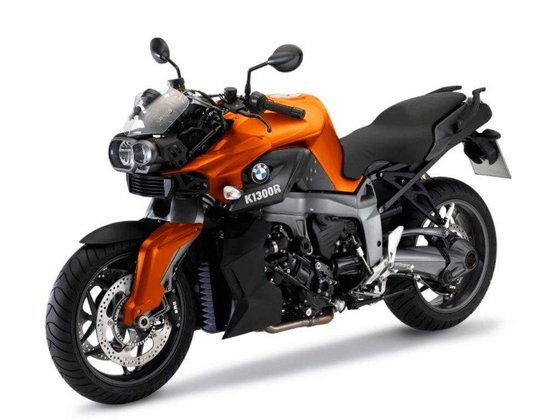
The BMW K 1300 R isn’t just a motorcycle—it’s a statement. Its combination of brute-force power, innovative suspension, and long-distance comfort makes it a rare all-rounder in the naked bike world. While newer models have eclipsed it in tech, few bikes from this era deliver the same visceral thrill paired with Bavarian reliability.
Whether you’re carving mountain passes or hunting for garage-upgrade projects (we see you, aftermarket exhaust shoppers), the K 1300 R remains a compelling choice. At MOTOPARTS.store, we’re here to help you keep yours roaring for another decade.
Ready to enhance your K 1300 R? Explore our curated selection of performance and comfort upgrades today.








Specifications sheet
| Engine | |
|---|---|
| Stroke: | Four-stroke |
| Battery: | 12V / 14AH maintenance-free |
| Max power: | 127 kW | 170.0 hp |
| Max torque: | 140 Nm |
| Fuel system: | Electronic fuel injection with Digital Motor Electronics (BMS-K) |
| Max power @: | 9250 rpm |
| Displacement: | 1298 ccm |
| Max torque @: | 8250 rpm |
| Configuration: | Inline |
| Cooling system: | Liquid cooled |
| Alternator output: | 580W |
| Compression ratio: | 13.0:1 |
| Number of cylinders: | 4 |
| Dimensions | |
|---|---|
| Wheelbase: | 1585 mm (62.4 in) |
| Dry weight: | 217 |
| Wet weight: | 243 |
| Seat height: | 790-820 mm (31.1-32.3 in) |
| Overall width: | 856 mm (33.7 in) |
| Overall height: | 1095 mm (43.1 in) |
| Overall length: | 2228 mm (87.7 in) |
| Ground clearance: | 165 mm (6.5 in) |
| Fuel tank capacity: | 19 L (5.0 US gal) |
| Drivetrain | |
|---|---|
| Final drive: | shaft |
| Gear ratios: | {'1st': 2.398, '2nd': 1.871, '3rd': 1.525, '4th': 1.296, '5th': 1.143, '6th': 1.015} |
| Transmission: | 6-speed manual |
| Shaft drive oil: | 180 ml 75W-140 GL-5 |
| Maintenance | |
|---|---|
| Engine oil: | 10W40 |
| Brake fluid: | DOT 4 |
| Spark plugs: | NGK KR9CI |
| Spark plug gap: | 0.8 |
| Coolant capacity: | 2.55 |
| Engine oil capacity: | 4.0 |
| Engine oil change interval: | Every 5000 km or 2 years |
| Valve clearance (intake, cold): | 0.20–0.28 mm |
| Valve clearance check interval: | 24,000 km (15,000 mi) |
| Valve clearance (exhaust, cold): | 0.30–0.40 mm |
| Recommended tire pressure (rear): | 2.9 bar (42 psi) |
| Recommended tire pressure (front): | 2.5 bar (36 psi) |
| Additional Features | |
|---|---|
| Safety: | ['Anti-lock braking system (ABS)', 'Automatic Stability Control (ASC)'] |
| Electronics: | ['On-board computer', 'Heated grips (optional)', 'LED indicators (optional)', 'Electronic Suspension Adjustment II (ESA II, optional)', 'Gear Shift Assist (optional)'] |
| Special Options: | ['HP carbon components', 'Akrapović titanium exhaust', '2D instrument cluster'] |
| Chassis and Suspension | |
|---|---|
| Rake: | 60.4° |
| Frame: | Aluminum bridge frame with load-bearing engine |
| Trail: | 104.4 mm (4.1 in) |
| Rear tire: | 180/55 z-17 |
| Front tire: | 120/70 z-17 |
| Rear brakes: | 265 mm disc with 2-piston caliper (ABS optional) |
| Front brakes: | 2 x 320 mm discs with 4-piston calipers (ABS optional) |
| Rear suspension: | Paralever single swing arm with hydraulic preload adjustment |
| Front suspension: | BMW Motorrad Duolever with central spring strut |
| Rear wheel travel: | 135 mm (5.3 in) |
| Front wheel travel: | 115 mm (4.5 in) |



